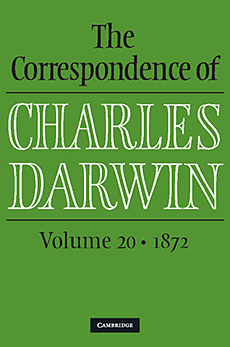Darwin's correspondence provides us with an invaluable source of information, not only about his own intellectual development and social network, but about Victorian science and society in general.
Letters form the largest single category of Darwin's working papers (there are details of around 15,000 on this site) and were one of the most important means by which he gathered data and discussed ideas. They provide a remarkably complete picture of the development of his thinking, throwing light on his formative years and the years of his voyage around the world on H.M.S. Beagle. The letters also chronicle the period that led up to the publication of his controversial theory of the transmutation of species by means of 'natural selection' in On the Origin of Species, and the subsequent heated debates.
In the 1860s and 1870s, Darwin was, additionally, busy with botanical investigations: studying adaptations in orchids, different types of sexual reproduction in other plants, the origin of climbing plants, and the physiology of insectivorous plants. The letters illustrate how this work, and his studies of human descent, sexual selection, and the expression of emotions, all contributed to the refinement of the theory presented in Origin. Darwin discussed these ideas in correspondence with other notable scientific figures such as the geologist Charles Lyell, the botanists Asa Gray and Joseph Dalton Hooker, the zoologist Thomas Henry Huxley and the naturalist Alfred Russel Wallace. The letters therefore also add to our understanding of their own work and opinions.

The letters provide equally valuable insights into the lives and work of many men and women who would otherwise be unknown. Darwin maintained widespread contacts in Britain and overseas with gardeners and nurserymen, diplomats, army officers, colonial officials, and naturalists, who provided him with observations on the fauna, flora, and peoples of the world. The correspondence also reveals the extent to which his children and other members of his family helped collect evidence that Darwin hoped would support his theories.
Through his letters, Darwin may also be placed firmly in the context of his time, not just as a great scientist and thinker, but also as a Victorian gentleman, who shared the daily domestic occupations and concerns of his class. He was an affectionate husband and father, who worried about the welfare and education of his children and was continually anxious about his own health and that of his family; he was an opponent of slavery and a supporter of local charitable works; a careful investor, and a generous friend and patron.


